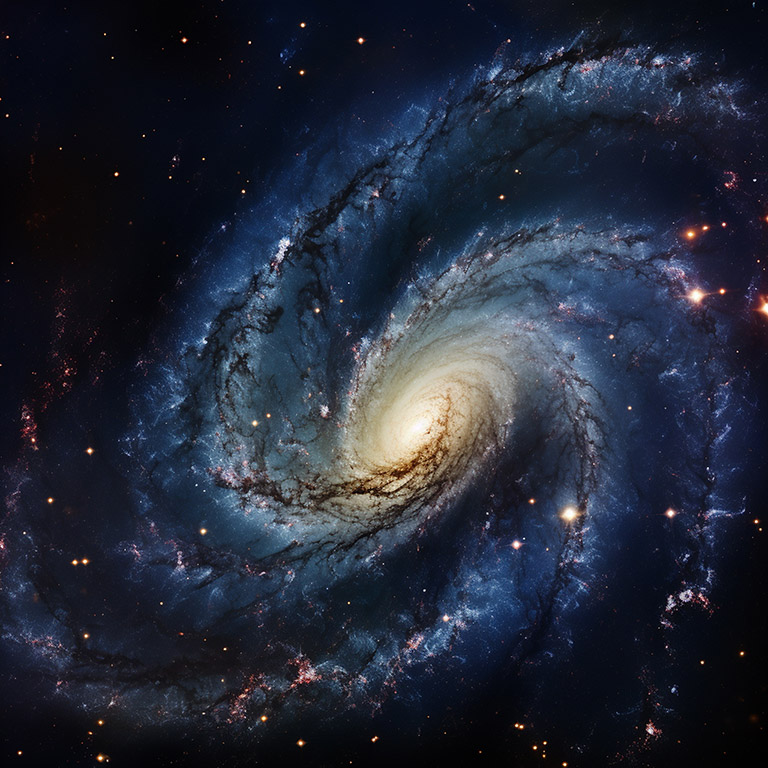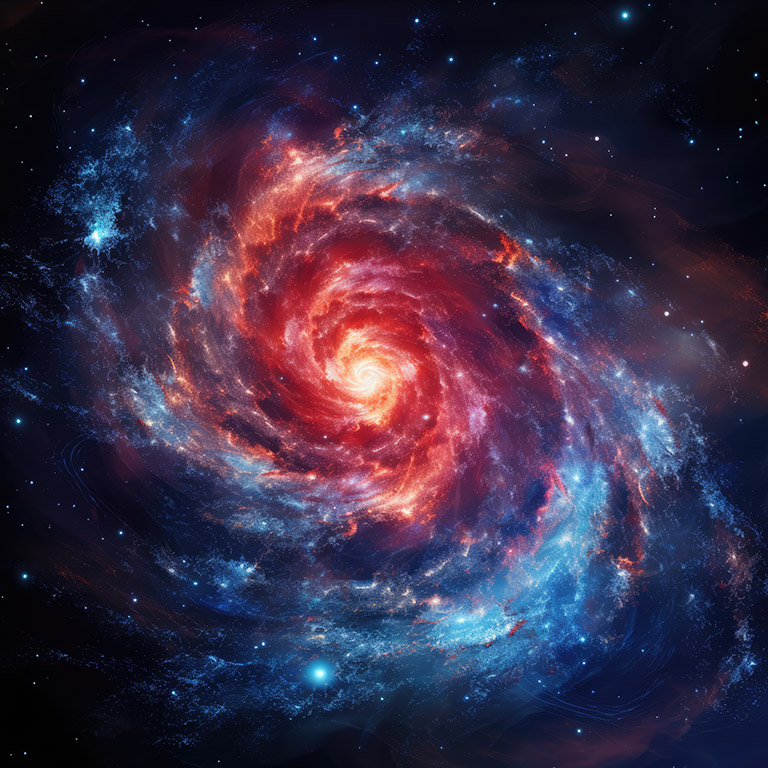The Milky Way galaxy, a vast and enchanting spiral structure that houses our solar system, is a subject of relentless study and fascination among astronomers and astrophysicists. Comprising billions of stars, clouds of gas and dust, and various celestial phenomena, this galaxy holds many mysteries that challenge our understanding of the universe. This article aims to explore the multiple facets of the Milky Way, addressing its structure, composition, formation, and the enigmas that surround it.
1. Introduction to the Milky Way Galaxy
The Milky Way is not only our home galaxy but a massive system of stars, stellar remnants, interstellar gas, dark matter, and cosmic dust. It is classified as a barred spiral galaxy, with a distinct bar-shaped core and spiral arms that radiate outward. Its diameter is estimated to be about 100,000 light-years, and it contains between 100 billion to 400 billion stars.
The term “Milky Way” originates from its appearance—a dim, milky band of light stretching across the night sky, composed of countless stars that are too faint to distinguish individually. Historically, various cultures have assigned mythological significance to this luminous band, but modern astronomy seeks to uncover its scientific mysteries.
1.1. The Position of Our Solar System
Our solar system resides in a suburban area of the Milky Way, around 27,000 light-years from the galactic center, located in the Orion Arm, also known as the Orion Spur. This positional context is crucial for understanding our galactic environment, gravitational influences, and potential interactions with nearby star systems.


2. Structure of the Milky Way Galaxy
Understanding the structure of the Milky Way is fundamental to unraveling its mysteries. The galaxy comprises several key components:
2.1. The Galactic Disc
The bulk of the Milky Way’s stars, gas, and dust is contained within the flat, rotating disc. This disc is characterized by spiral arms, where stellar formation is vigorous, and areas of higher density lead to the birth of stars.
2.1.1. Spiral Arms
The spiral arms of the Milky Way are sites of active star formation and are rich in molecular clouds. These arms include:
- The Perseus Arm
- The Scutum-Centaurus Arm
- The Carina-Sagittarius Arm
- The Cygnus Arm
The arms are not fixed; rather, they are dynamic structures that change over time due to the gravitational influence of stars and molecular clouds.
2.2. The Galactic Bulge
At the center of the Milky Way lies the galactic bulge, a dense sphere of stars that hosts a supermassive black hole known as Sagittarius A*. This region is thought to contain about 10 million to 50 million stars concentrated in a relatively small volume, resulting in a high gravitational pull.
2.3. The Halo
Surrounding the galactic disc and the bulge is the halo, a roughly spherical region that extends much further out. The halo contains older stars, globular clusters, and a substantial amount of dark matter, which is critical in understanding the galaxy’s gravitational behavior.
2.4. Dark Matter
One of the most intriguing components of the Milky Way is dark matter, a substance that does not emit or interact with electromagnetic radiation as regular matter does. Its existence is inferred from gravitational effects on visible matter, radiation, and the large-scale structure of the galaxy. Research estimates that dark matter may comprise up to 90% of the Milky Way’s total mass.

3. Composition of the Milky Way Galaxy
Understanding what the Milky Way is made of is essential to exploring its history and future.
3.1. Stars
The Milky Way consists of various star types, each contributing to the galaxy’s evolution:
- Main Sequence Stars: The most abundant type, including our Sun, they fuse hydrogen into helium in their cores.
- Red Giants: These stars have exhausted hydrogen in their cores and will eventually shed their outer layers.
- Neutron Stars and Black Holes: The remnants of supernova explosions, these compact objects demonstrate extreme gravitational forces.
3.2. Gas and Dust
The interstellar medium (ISM) is composed primarily of hydrogen gas, along with helium and trace amounts of heavier elements. This medium plays a vital role in star formation and the overall chemical evolution of the galaxy. The dust within molecular clouds is crucial for cooling, enabling the collapse of gas into new stars.
3.3. Cosmic Background Radiation
The Cosmic Microwave Background (CMB) provides a snapshot of the early universe, offering insights into the composition of the Milky Way and its surroundings. By studying the CMB, astronomers can glean details about the distribution of dark matter and the formation of large-scale structures.
4. Formation and Evolution of the Milky Way
The Milky Way’s history spans billions of years, and its formation involves complex processes that are still subjects of research.
4.1. Theoretical Models of Formation
Current theories suggest that the Milky Way formed through a combination of gravitational collapse and mergers with smaller galaxies. Over time, accretion of gas and dust fueled star formation while interactions with other galaxies shaped its structure.
4.2. The Role of Dark Matter
Dark matter played a critical role in the formation of galaxies, including the Milky Way. Its gravitational influence facilitated the gathering of regular matter into denser regions, leading to the formation of stars and stellar clusters.
4.3. Mergers and Interactions with Other Galaxies
Galactic mergers have been common throughout the history of the Milky Way. Evidence of past interactions can be observed in the form of stellar streams and disrupted globular clusters. The Milky Way is currently on a collision course with the Andromeda galaxy, expected to occur in about 4.5 billion years.
5. The Dynamics of the Milky Way
The dynamics of the Milky Way involve its gravitational behavior, rotation, and the motion of its constituent stars.
5.1. Galactic Rotation
The Milky Way rotates as a whole, with different parts moving at varying speeds. The outer regions of the galaxy, where our solar system resides, rotate more slowly than the inner regions—an observation that leads to the concept of “galactic rotation curves.” The unexpected flatness of these curves provides insights into the distribution of dark matter.
5.2. vv
The stars within the Milky Way are not stationary; they orbit the galactic center in well-defined paths. These orbits can be influenced by the gravitational pull of nearby stars, dark matter, and the galaxy’s overall gravitational potential.
5.3. Galactic Cannibalism
The history of the Milky Way is marked by “galactic cannibalism,” a process in which larger galaxies merge and absorb smaller ones. This phenomenon has significantly altered the structure and star population of the Milky Way throughout its evolution.
6. The Mysteries Surrounding the Milky Way
Despite extensive research and observations, numerous mysteries continue to perplex astronomers regarding the Milky Way.
6.1. The Nature of Dark Matter
Though the existence of dark matter is well-supported, its exact nature remains unknown. Multiple leading candidates, including Weakly Interacting Massive Particles (WIMPs) and axions, are under investigation. Understanding dark matter is crucial for explaining the galaxy’s structure and dynamics.
6.2. Galactic Center vs. Supermassive Black Holes
The supermassive black hole at the Milky Way’s center, Sagittarius A*, poses significant questions regarding its growth and the dynamics of stars near it. Recent research indicates that stars orbiting Sagittarius A* display peculiar behaviors, providing opportunities for studying fundamental physics.
6.3. The Spiral Structure
The formation and maintenance of the Milky Way’s spiral structure remain areas of active research. Questions arise surrounding how spiral arms form and why some galaxies exhibit different structures, including grand-design spirals versus flocculent spirals.
6.4. Stellar Populations and Chemical Evolution
Different stellar populations exist within the Milky Way, differentiated by their metallicity and age. Understanding how these populations evolve over time helps astronomers piece together the galaxy’s history and the processes that drive star formation and chemical enrichment.
6.5. The Quest for Dark Energy
Although often associated with the overall structure of the universe, dark energy plays a crucial role in galaxy dynamics and evolution. Understanding its implications within the context of the Milky Way adds another layer of complexity to our investigations.
7. Observational Techniques in Milky Way Research
Modern astronomy employs various observational techniques and tools to study the Milky Way galaxy. These methods enable astronomers to gather data across multiple wavelengths and enhance our understanding of galactic structures and phenomena.
7.1. Optical Observations
Telescopes operating in the optical spectrum provide valuable insights into the distribution of stars, gas, and dust within the Milky Way. Surveys like the Sloan Digital Sky Survey (SDSS) have enriched our understanding of stellar populations and galactic structure.
7.2. Radio Astronomy
Radio telescopes are instrumental in observing the interstellar medium and studying star formation regions. Observations of the 21-cm hydrogen line enable astronomers to map the distribution of neutral hydrogen gas, revealing dynamics and structure within the galaxy.
7.3. Infrared Observations
Infrared telescopes, such as the Spitzer Space Telescope, play a critical role in penetrating dust clouds, allowing astronomers to study star formation and the chemical composition of regions obscured in optical observations.
7.4. X-ray and Gamma-ray Observations
High-energy astrophysics provides unique insights into energetic processes occurring in the Milky Way. Observations from X-ray and gamma-ray observatories reveal information about supernovae, black holes, and neutron stars, contributing to our understanding of extreme environments.
8. Future Prospects for Milky Way Research
As technology advances, the ability to study the Milky Way and its mysteries will exponentially increase. Several upcoming projects and missions aim to enhance our knowledge of the galaxy.
8.1. The James Webb Space Telescope (JWST)
Scheduled for launch in December 2021, the JWST is poised to revolutionize our understanding of the Milky Way through infrared observations. Its sensitivity will allow astronomers to peer deeper into star formation regions and study distant galaxies.
8.2. The European Space Agency’s Gaia Mission
The Gaia satellite, launched in 2013, aims to create a 3D map of the Milky Way by measuring the positions and motions of millions of stars. Gaia’s data will yield unprecedented insights into stellar populations, chemical composition, and galactic dynamics.
8.3. Large Surveys and Observational Campaigns
Future astronomical surveys—including the Wide-Field Infrared Survey Telescope (WFIRST) and the Vera C. Rubin Observatory—are expected to provide comprehensive datasets to tackle previously unanswered questions about the Milky Way’s formation and evolution.
9. Conclusion
The Milky Way galaxy, a magnificent realm that contains not only our solar system but billions of stars and celestial phenomena, remains enigmatic and inadequately understood. Despite significant advancements in technology and our comprehension of galactic structures, essential mysteries endure.
Through continued research, advanced observational methodologies, and collaborative efforts from astronomers worldwide, humanity is continually unraveling the complexities of the Milky Way. As we venture deeper into the realm of galaxy science, we are reminded of the profound connections in the universe—the shared cosmic story of stars, planets, and the very fabric of existence itself.
References
- Binney, J., & Merrifield, M. (1998). Galactic Astronomy. Princeton University Press. Link to Princeton Press.
- Kormendy, J., & Ho, L. C. (2013). Coevolution of Supermassive Black Holes and Their Hosts. Annual Review of Astronomy and Astrophysics, 51, 511–653. Link to Annual Reviews.
- Garrison, R. F., & D. A. McGowan. (1996). The Formation and Evolution of the Milky Way. Nature, 382(6593), 436–441. Link to Nature.
- Gerhard, O. (2013). The Structure and Formation of the Milky Way. Nature, 495, 61–68. Link to Nature.
- Oort, J. H. (1932). The Formation of the Milky Way. The Astrophysical Journal, 75, 539–550. Link to The Astrophysical Journal.
- McMillan, P. J. (2017). The Milky Way’s Mass Distribution and Its Halo. The Astronomical Journal, 832(2), 240–252. Link to The Astronomical Journal.
- Sanders, R. H., & Tubbs, A. D. (1980). The Structure of the Milky Way. The Astrophysical Journal, 236, 518–526. Link to The Astrophysical Journal.
This extensive exploration of the Milky Way galaxy provides an academic perspective on its mysteries, structures, and composition, contributing to the ongoing dialogue in astronomical research. By continually investigating the complexities of our galactic home, we strive to understand our place in the universe and the forces that govern celestial phenomena.




1 Comment
Sam
Nice 👍